Grilling with Thermometers: Probe Safety
Here at ThermoWorks, we get lots of questions about using our leave-in-probe thermometers—like Smoke™, ChefAlarm® or DOT®—while grilling. The great thing about leave-in probe thermometers is that they allow you to track changes in temperature over time and can alert you when you get to your target. But is using them when grilling a good idea?
“GRILLING” = HIGH HEAT ENVIRONMENT
Grilling is, by definition, cooking food over the intense heat of an open flame. Because of the intensity of the cooking environment, the internal temperature of grilled foods usually increases rapidly—making it easy to miss your target temperatures and overcook. So using a leave-in probe thermometer (sometimes called a cooking alarm) to track internal temperatures would seem to be a winning idea.
In fact, it can be if you use the right kinds of probes and follow a few safety precautions. Most probes, however, are not cut out for grilling applications.
Grill temperatures can vary, of course, depending upon the fuel and the construction of the grill, but grill surface temperatures are commonly between 400 and 600°F (204 and 315°C). Those are temperatures high enough to burn out probes made by our competitors, but ThermoWorks probes can withstand ambient temperatures up to 700°F (370°C).
THE FLARE-UP: WHERE PROBES GO TO DIE
There is one thing, though, that can easily burn out even ThermoWorks probes: the flare-up.
Flare-ups occur when liquids (fats or oils) are expelled from meats on the grill and drip down onto the fire or coals. Fats act as fuel, propelling an open flame up to the grill surface, and sometimes higher. The temperature of those flames can exceed 1,000°F (538°C), and even armored, high-quality probe cables like those featured in ThermoWorks Pro-Series® Probes max out at 700°F (370°C).
This is why, as a general rule, we don’t recommend using leave-in thermometers for grilling applications. Our leave-in probe thermometers and probes are purpose-built for low-and-slow cooking environments, like ovens and smokers. But even our high-quality, high-temp probes can be burnt out by flare-ups on the grill. So if you’re planning to use a leave-in probe while grilling, you need to take steps to insulate your probes and cables from flare-ups. The probe tip itself should be safely tucked away in the meat or whatever you are measuring, but you still need to be careful with your cables.
HOW TO PROPERLY USE LEAVE-IN PROBES WHILE GRILLING
Remember, even ThermoWorks probe cables are only rated to 700°F (370°C) for Pro-Series Probes. So to help mitigate risk to your probes, here are some steps that careful cooks take to make it possible to use leave-in probes and thermometers like the Smoke, DOT or ChefAlarm while grilling:
- Insert your cooking alarm leave-in probe through the holes and grommets specifically designed for probes on grills rather than closing the cable in the grill lid. This will help keep the cables off the surface of the grill where it can get too hot.
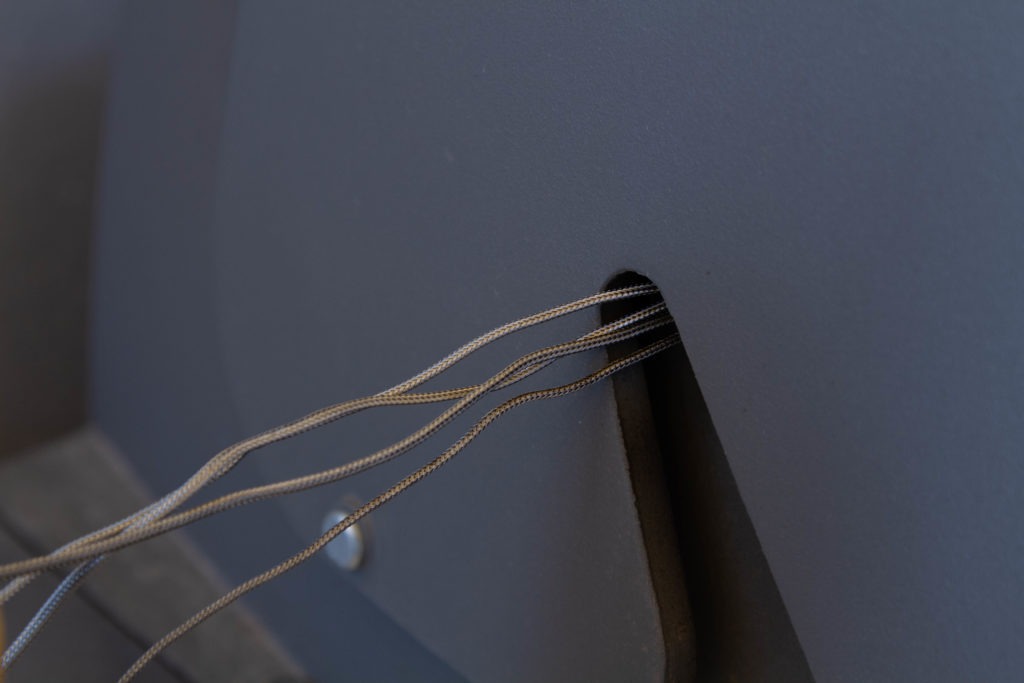
- Insert the probe into food on the grill NEAR the grommet or opening, so that the cable does not need to be draped across the grill grates themselves.
- If necessary, wrap the probe cable and transition with aluminum foil to further reflect the high heat of flare-ups. You can also use a little foil to group multiple probe cables together, directing them toward the grill grommet or opening and away from the grilling surface.
PROBE CONSTRUCTION MAKES A DIFFERENCE
Simply put, ThermoWorks probes are the best probes you can buy for cooking, smoking, and grilling. Our probes are manifestly more accurate, more robust, and longer lasting than the competition. Let’s take a look at ways that ThermoWorks probes are superior to the competition.
- ThermoWorks probes have reinforced transitions. The junctions between the cable and the probe itself and the junction between the cable and the plug are the most likely parts of the probe to fail. ThermoWorks probes feature reinforced heat-resistant transitions and springs around the cables to prevent kinking. The competitors’ probes often feature metal transitions or machine-pressed seals that let the heat in and are more subject to metal fatigue.
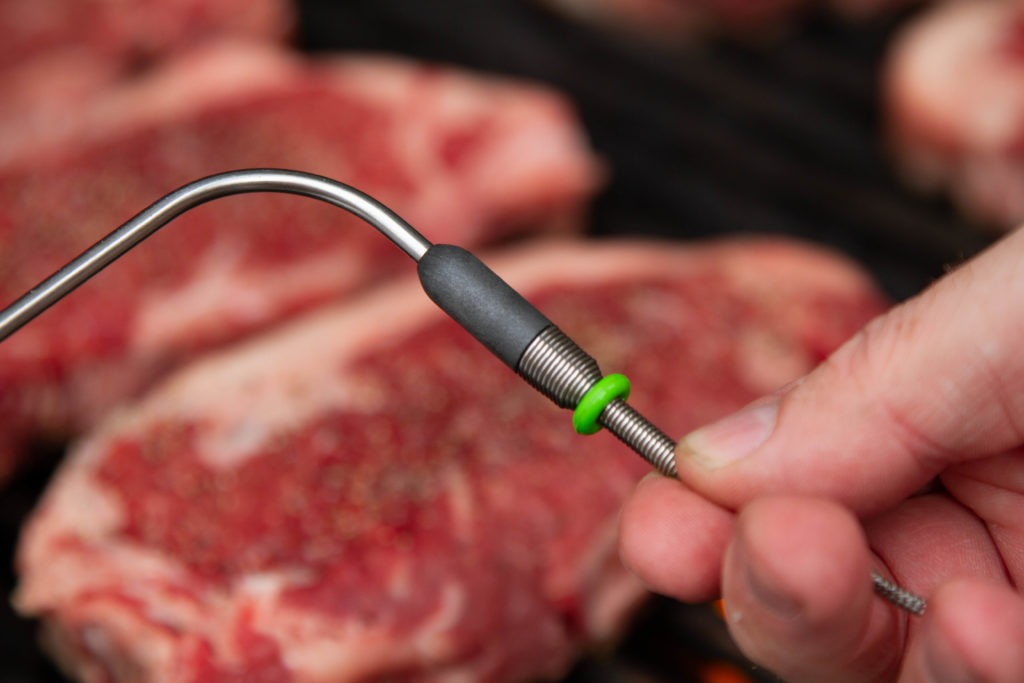
- ThermoWorks probes feature reinforced cables. ThermoWorks probe cables are insulated and reinforced with silicone or metal braiding for great heat resistance and durability.
- ThermoWorks probes are built on more accurate sensors. ThermoWorks thermistor sensors used in our Pro-Series probes are widely known to be the most sensitive and accurate sensors in their class.
- ThermoWorks probes come with published specifications. Good luck finding the maximum-allowable exposure temperatures listed for either the cable or the transition with our competitors’ probes. ThermoWorks publishes complete specs for each of the probes we sell, including…
- Sensor rangeCable max tempTransition max tempWarranty
- Probe and transition dimensions
- Cable length
(We sometimes see owners of our competitors’ products posting on BBQ and cooking forums about buying ThermoWorks probes and plugging them into their non-ThermoWorks meters. But since each brand of thermometer actually calibrates their readout electronics to work with their own brand of probes, their electronics might give false readouts with our probes. We don’t recommend this practice.)
A FINAL NOTE ON GRILLING WITH PROBES
While our probes are designed to be best of class (each batch is tested to make sure they meet our high-quality standards) and are much heartier than those of our competitors, all cooking probes—no matter what type they are, how expensive they are, or who makes them—are subject to decay over time due to the harsh conditions they are used in. Professional BBQ teams always keep extra probes on hand for this reason. Plus, it never hurts to have more types of probes on hand to handle different kinds of cooks!
In the end, it’s important to recognize that there will always be risks when using leave-in probe thermometers while grilling. Flare-up temperatures are too high for probe cables and transitions and can easily burn them out. But the simple steps outlined above, if carefully followed, can help you avoid exposing your probe cables to flare-ups or hot spots and help them stay in good working condition.


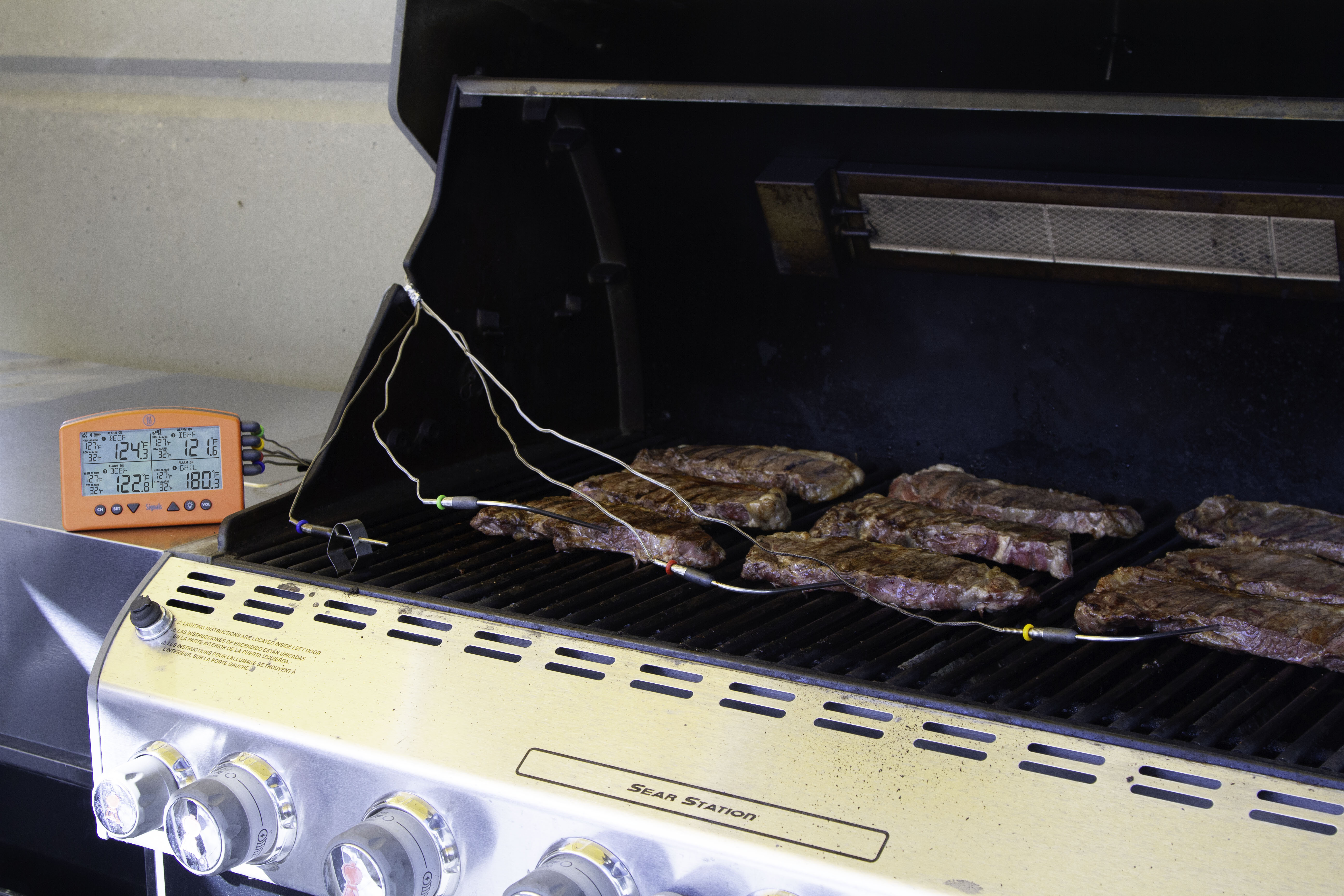
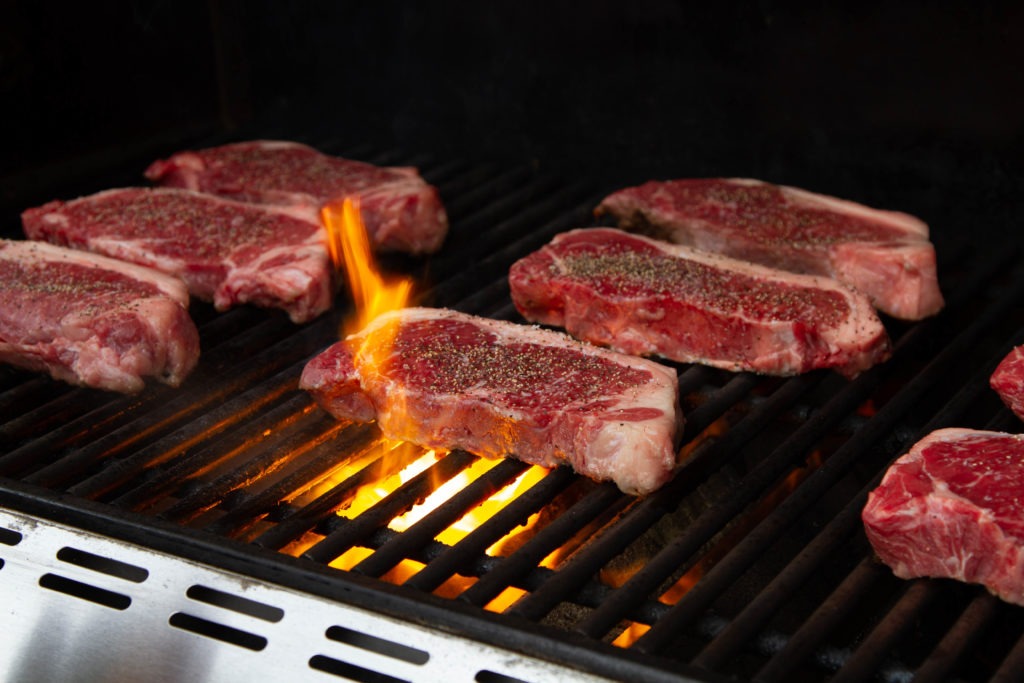

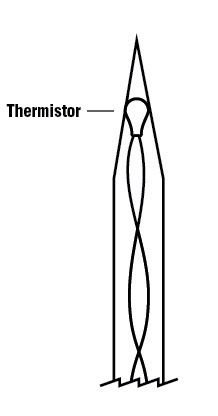

Oooh! When does the “Signals”/4-channel Smoke go on sale? Love it!
Tom,
Keep your eyes out for an announcement soon.
The thermometer featured in the pics for this post appear to be a 4 channel Smoke. Am I correct? If so, when do you anticipate it’s release? This is a game changer and something I’m definitely interested in purchasing. Please let me know!
Dave,
An announcement is coming soon.
Been cooking long time and had no clue as to how to use. Thanks very interesting.
Great Article! I am in need of some way to color code both ends of the probe wires. Why? I usually run three to four probes using the Smoke, ChefAlarm and a Dot. It would be nice to know / Remember, which hunk of food is on what device! I noticed in your article that the one probe had a green ring and got excited!
Robert,
We’ll have those available very soon so you can keep track of your cooks better!
what unit were you showing that can measure up to 4 probes?
Ron,
Signals is coming soon.
What is the 4 channel in this ad called I cannot find it??? Would like to purchase
Matt,
Keep your eyes open for an announcement soon!
Exactly what is that four-channel thermometer? I can’t find it on the web site.
Jeffrey,
Oh, the Signals? It’s coming soon…
Many grills or smokers don’t have grommets, and for ssmoking it’s important to be able to close the lid. May I suggest that you consider selling a high-temperature-resistant sleeve to fit over the probe cable when smoking meat so that the lid can be closed?
Sam,
Interesting idea!
Is that a Smoke 2.0 with 4 probes and built in WiFi.
Adam,
What you see is Signals. I can’t comment on any features, but I can say that the announcement is coming soon.
Wht product is in the first picture? It looks like a 4 channel smoke which I’ve not seen before!
Tom,
That’s our forthcoming product launch, the Signals! Keep an eye out for an announcement very soon!
How far into the meat does the probe need to be to avoid heat conduction from the grill temperature affecting the temperature at the tip of the probe?
Jim,
As long as it’s in meat it should be safe. If your meat gets over 700°F, well, it’s toast anyhow.
Hi!
Is that a 4 channel Smoke in the pictures? I can’t find it anywhere on the sight. Interested/interesting!
Frank,
That’s our forthcoming product launch, the Signals! Keep an eye out for an announcement very soon!
If a probe or cable does go bad will there be no reading at the meter or will there be an inaccurate reading ? What should I be looking out for ?
Curt,
You will get an error reading, not an inaccurate temperature.
You end up with “HHH” when the probe is cooled off and plugged in. I just had this happen this weekend. A flare up melted my primary 90 degree probe and it just reads “HHH” when I plug it in. :-/ Definitely something to watch out for.
Great info! Thanks.
Is the pictured probe thermometer in this article what I think it is?!?! It looks to be a version of smoke but with four probes and is branded with ThermoWorks logo and the name “Signals” Please please please tell me this is coming out before Christmas because I know what’s at the top of my list now!
Scott,
I won’t way when Signals is coming out, but I will say that you should be watching your ThermoWorks emails in the next while.
Hi, I own the Smoke 2-channel Alarm. It came with the Pro-Series® High Temp Cooking Probe, Pro-Series High Temp Air Probe. For deep frying a turkey can either of these probes actually go into the breast and then into the cooking oil while the turkey is cooking? As you know, the peanut oil gets to 350 degrees.
If not, is there another probe to use I can buy that will work with this device?
Thanks
Paul,
Sadly you cannot submerge it like that. The issue there isn’t temperature but the oil itself. Oil will work its way into the transitions and start to corrode the insulation and the coatings on the wires.
I would recommend buying a 12″ probe that you can place in the breast while keeping the transitions out of the oil.
Nice article…but how can I get the 4 channel alarm?
John,
You must wait! But not very long…
I’m 110% delighted with all my ThermoWorks products. Time Stick, Time Stack, Ir-Gun, Dot, Chef Alarm & Pen.
The products and customer support are the best.
IMO there is no competetion out there.
Hey – thanks for the article. In my experience GrillGrates are an excellent way to prevent flareups while giving perfect grill marks.
Love your products!
When will the 4 probe Smoke become available
Watch your email soon…
Were in South africa get one.
Adriaan,
You can buy a Signals from our website and we will ship it to South Africa. Unfortunately, we don’t have any distributors there.
Hi,
Is that a 4-channel Smoke in the photos?
David
The Signals is coming soon!
Yup, although it was NOT clear and I used a DOT for grilling and it burned out first time, the company was nice enough to replace the probe. Smartly, they have published this article, and it was probably NOT because I was the only one with “burn-out” issues! Now I don’t know if I want to even TRY to use what I thought was the probe for grilling if I have to cover it with foil and take my chances…
KB,
You are not the only one, indeed! Like it says in the article, it really is risky, but it can certainly work. But it is totally a personal decision!
Best recommendation for smoking and remote via receiving or via cell phone..
This is all very helpful information. However, it would be great for a design that would withstand temperatures approaching 1000 degrees. Even at a higher cost, these would be a valuable investment.
What is the temperature measuring unit in the picture above? It has 4 inputs…..something new ????
That’s our forthcoming product launch, the Signals! Keep an eye out for an announcement very soon!
I can’t find this 4 channels ThermoWorks!
Gilles,
Look for word on that very soon!
Thanks for your informative warning. I hope that Thermo works is developing special protective “sleeves” for cables to withstand potential flare-ups while grilling.
Is that a 4 channel Smoke? I can’t find it on the site. When will it be available?
Russ,
Keep an eye out for an announcement soon…
The thermometer pictured in your article about probe safety has 4 probes plugged into it. However, I can’t seem to find it on your website. Please advise were I can find that one.
Thanks.
Bobby,
That’s our forthcoming product launch, the Signals! Keep an eye out for an announcement very soon!
The orange and yellow thermometers photos, are they on the web site? I could not find them.
Thanks,
Sandy
Keep an eye out for an announcement very soon!
Thanks for this info
on protecting our probes during high heat cooks. What is the best way to clean the CABLE? The probes clean up pretty good with a soapy plastic scrubby but after several low & slow cooks the cables get pretty grungy.
Mike,
Indeed they can get grungy! A little degreaser kitchen cleaner (something like 409) works well. Spray some into a cloth and use the cloth to wipe it down. I hope that helps!
What is the device that shows 4 probes connected. See picture under your item 2. Didn’t see a comparable device on your website.
That’s our forthcoming product launch, the Signals! Keep an eye out for an announcement very soon!
Bought our “Smoke” unit almost 2 years ago and it still works perfectly. Others we have tried never lasted more than about 6 uses, making the end cost a lot more than the Thermoworks Smoke. Get the best, then you don’t have to worry, and you can sit back and enjoy your food.
Sheldon,
Thanks for your comment! You’ve hit the nail on the head with that!
A couple of outdoor cooking groups I follow on Facebook have, allegedly , scoured your Thermoworks site looking for this specific setup. And claim it’s not on your site. It this gear ready for sale? I ask because I, too, have been a very big fan of your products and, most importantly, the staff!!!
Ah! You spotted it! That’s our forthcoming product launch, the Signals! Keep an eye out for an announcement very soon!
I am soooo upset! I just got my Smoke and LOVE it. But now you are making a 4 probe version????? Damn! I should have waited.
I have a Kamado Joe and a Chef Alarm. Is it safe to use the probe threaded between top lid and top of the main smoking chamber with the heat deflectors in place? The unit seals with a wire mesh fiberglass gasket. I’m worried about crimping.
Paul,
Watch the angle going in, but it should be ok from a crimping standpoint. Just make sure your cable goes over one of the legs of the deflector!
Got my Smoke + Gateway a few months ago and love it. Hoping this 4 channel is going to be compatible with the Gateway.
Kevin,
Actually, the Signals has the wifi built in! It needs no gateway to connect with your phone, and it still uses the same app.
Will Signals be paired with a 4 channel Gateway?
Robert,
Signals doesn’t need a gateway to pair! It has native Bluetooth and Wifi built in, so no additional equipment is necessary.
Nice article. My Smoke probe connects to smoke and the display frequently goes to – – – until I twist it around in socket until temp display comes back on. Is this typical of a fritzed out probe???
Allan,
You might want to give our experts in our Tech Support department a call. Call ThermoWorks at 800-393-6434 and ask for tech support. They will know how to tell what’s up!
Other than tin foil is there any other sleeve product that can be used to protect cable probes.
Anything flame/fire proof should work, but I’m having a hard time thinking of something!
I smoked a tomahawk last night with new Signals. The unit said it was 136F. But when I cut it open it was still raw. What did I do wrong?
It’s probable that the part of the steak the probe was in was at 136°F but that the tip of the probe was not in the thermal center of the steak. That’s why we encourage confirming internal temperatures with and instant-read thermometer. Even after all the steak cookery I’ve done, I still get surprised by doneness from time to time—the probe placement matters a LOT.